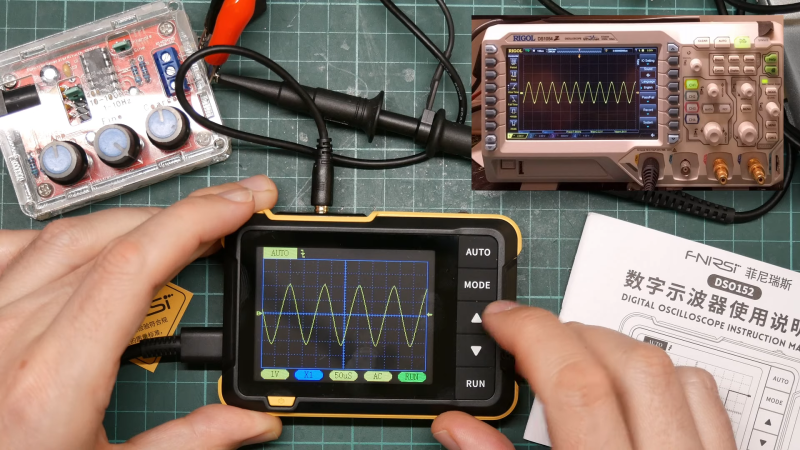You know things are getting real when the Dremel is one of the first tools you turn to after unboxing your new oscilloscope. But when your goal is to hack the scope to play Breakout, sometimes plastic needs to be sacrificed.
Granted, the scope in question, a Fnirsi DSO152, only cost [David Given] from Poking Technology a couple of bucks. And while the little instrument really isn’t that bad inside, it’s limited to a single channel and 200 kHz of bandwidth, so it’s not exactly lab quality. The big attractions for [David] were the CH32F103 microcontroller and the prominent debug port inside, not to mention the large color LCD panel.
[David]’s attack began with the debug port and case mods to allow access, but quickly ground to a halt when he accidentally erased the original firmware. But no matter — tracing out the pins is always an option. [David] made that easier by overlaying large photos of both sides of the board, which let him figure out which buttons went to which pins, and mapping for the display’s parallel interface. He didn’t mess with any of the analog stuff except to create a quick “Hello, oscilloscope!” program to output a square wave to the calibration pin. He did, however, create a display driver and port a game of breakout to the scope — video after the hop.
We’ve been seeing a lot of buzz around the CH32xx MCUs lately; seeing it start to show up in retail products is perhaps a leading indicator of where the cheap RISC chips are headed. We’ve seen a few interesting hacks with them, but we’ve also heard tell they can be hard to come by. Maybe getting one of these scopes to tear apart can fix that, though.
Thanks to [Bike Forever] for the heads up on this one.















In my naivety, I thought this would be a vector graphics game using only the standard inputs of the oscilloscope. 😐
CH32V series are the RISC-V architecture, while CH32F are ARM clones of STM32
Thank you for this comment! I didn’t know about WCH ICs and now I’m very happily waiting for CH582F & CH592F boards and their debugger from aliexpress. 10 boards in total for ~20eu. They’re BLE, have USB host & gadget, ADCs, n more and cost nothing
Thank you for the writeup!
Since I made that I discovered that there’s also a DSO153, which is basically the same thing but with a built-in signal generator. I can’t find a high-resolution picture of the motherboard but it looks like it’s a different microcontroller; my guess is that it’s a CH32F4 or similar. Because there’s a signal generator this means that there’s also an analogue output stage, which combined with the (probably) bigger microcontroller might make this a better candidate for building a custom tool such as a logic analyser. It’s unfortunately about $10 more expensive, but it is blue.
FYI link to the DSO153
https://m.banggood.com/FNIRSI-DSO153-2in1-Portable-Digital-Oscilloscope-Signal-Generator-1MHz-Bandwidth-5MSa-or-s-Sampling-Rate-Compact-Electronics-Repair-Tools-1000mAh-Battery-USB-Charging-Diverse-Waveforms-p-2011060.html
I should have set up an affiliate link. I could have made literally _dozens_ of cents!
Here’s a review of the DSO153. https://mysku.club/blog/aliexpress/99752.html The PCB photo is too low-res to read but they say it’s an AT32F423, which appears to have rather different specs than the ST32F423 (the Artery version has less RAM).
Does it do signal generation while scope-ing or do I need to buy two if I want to do signal tracing while on the road?
When I was first learning about electronics in the early 1980s (mostly self-taught with one grad-school course to help get up to speed), I used to buy cheap consumer devices, map out the pins & PCB and repurpose them, like this. I usually didn’t try to reprogram them though, because there just weren’t a lot of the helpful tools available back then that are available everywhere today.
Reminds me of some fun times. At least, it was satisfying back then.
Seems like a lot of trouble nowadays, for not so much gain.
But, back then it was all about learning.
Don’t fear the analog stuff! I started out with analog then taught myself digital, which is SO MUCH easier! But the analog isn’t as much “black magic” as people say. I say, if you can learn digital, you can learn analog. It’s different, but just in a different way!
Keep it up!